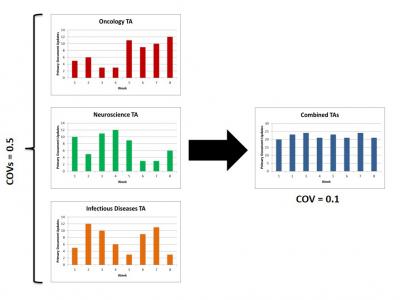Labelling Updates in Regulatory Affairs: Is product specific dedication of resources a good idea?
Managing changes to the content and format of product labelling is a key function within any Regulatory Affairs Organisation. Such functions are typically structured by therapeutic area, where each provides support for a reasonably small group of specific products.
This may sound like a good idea as it provides each therapeutic area with a fixed point of contact and the opportunity to work with people who have some knowledge of the labelling content and previous updates for specific compounds. However, organising in this manner carries a significant cost.
Figure 1. The impact of dedicated groups with volatile workloads
The graphs show the number of updates which each of the dedicated groups must manage on a weekly basis. The coefficient of variance (CoV – a normalized measure of volatility) for each is 0.5. If lead-times are to be maintained these groups would individually need to manage up to 12 updates per week (a total of 36 for the three groups). This could be achieved by either over-resourcing each group to the maximum capacity or by over-burdening people in busy weeks requiring them to work overtime.
If we look at the alternative where the three have been combined into one group the CoV has been dramatically reduced to just 0.1, and the peak number of updates has dropped to 24 (a 33% reduction).
We have observed that in managing labelling updates, process knowledge (being able to navigate the different types of updates and the various IT systems involved) is much more critical than any knowledge relating to specific compounds. Organising resources based on process allows us to operate in the manner outlined on the right of Figure 1, where different work-streams have been combined.
Lean tools for Regulatory Affairs
In order to enable us to implement this approach to “Lean Labelling” a number of tools / lean practices must first be put in place.
Structured queuing
All projects are entered in a centralised tracker, their work content estimated, and each placed in a queue according to order of priority.
Level loading
On a daily / weekly basis individuals in the group are assigned a fixed amount of work according to the level demand.
Flexible outsourcing
Despite our best efforts spikes in regulatory workload may still be inevitable and having a flexible outsourcing partner to act as a release valve during the busy periods is an important additional levelling tool.
Standard work
A standard and repeatable set of activities is documented for each task.
Performance management
KPIs for process and people are developed which allow for proactive identification and resolution of issues / opportunities for continuous improvement.
Our consultants can provide further information on the above and discuss any aspect of Real Lean Transformation, simply set-up a call today.

